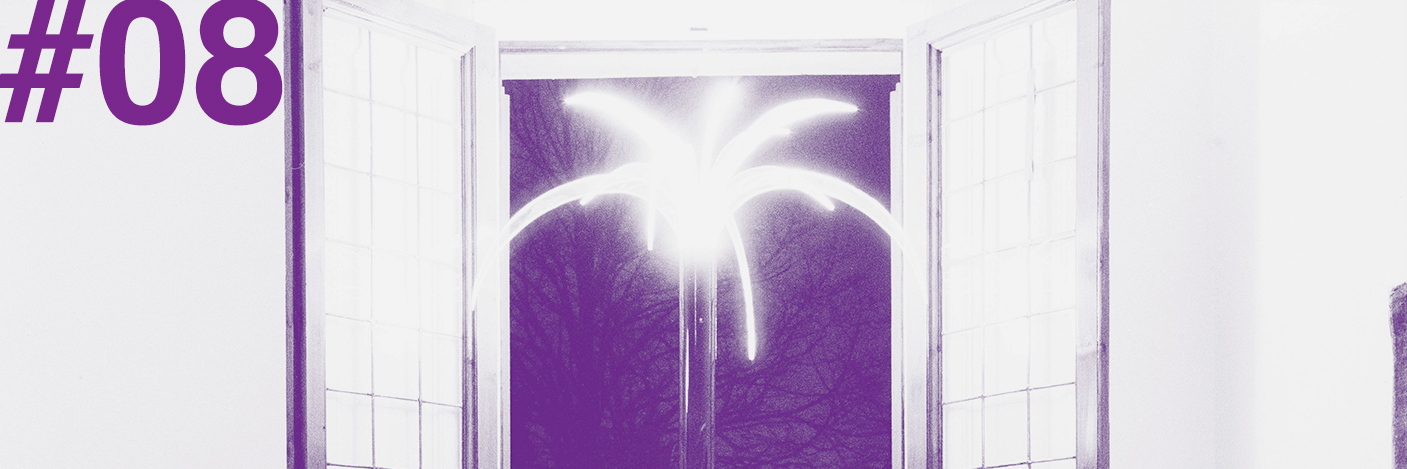
Design Break 08 — The story of a lamp, Christmas 1967. Dario Bartolini, Archizoom Associati
Before the Christmas holidays with my family, I gather together everything needed to build what I have in mind – a light source able to activate one of my creatures.
The light source is a palm, that absurd, branchless tree which has embellished the Italian Riviera since the beginning of the century, and an apt icon for the Afro-Tyrolese style we Archizoom profess. The leaves are plexiglas, luminous, on top of a tube.
The occasion. Lucia’s family (my future in-laws) and mine will meet for New Year’s in a non-neutral place, my parent’s house at Roccamare. My Archizoom friends, also invited, will make a raid into my territory.
The creature. For some time I’ve been building electronic devices able to emit a range of sounds triggered by varying light conditions. I persist in my efforts to build circuitry, sustained by a desire to involve others as ‘actors’ in a kind of musical production. In reality, the sounds generated are more or less unpleasant, unusual, unexpected. A rather naïf but strongly felt interpretation of Duchamp’s lesson: the other half of art is created by the viewer, the user.
The place. The house at Roccamare, designed by Ernesto Nathan Rogers in 1958 for my family, is a special home in a special place. There are traces of rationalism, softened by references to what Ernesto called “pre-existences”. The house sits in a pine grove, a few yards from Mediterranean scrub and sea. Its small tower with glazed windows, immersed in the treetops, is inspired by Tuscan farmhouses.
Up there on my own I dabble and tinker undisturbed, and unaccountable to my parents. I have from Christmas to New Year’s to build my installation.
The work. The biggest challenge: cutting the leaves from a plexiglas sheet with a toy fretsaw used by children to create scale models. Constantly I have to free the blade to prevent the bow from catching on the opposite rim of the piece I’m cutting, which is larger than the bow itself. Plexiglas is particularly hard and the work proceeds slowly.

The base is made of chipboard, painted make-believe-Carrara-marble-white, to which an upright tube will be attached with screws. I find a trunk for my palm at the village plumber’s: an orange PVC drain pipe. I paint it black, and it’s ready. The halogen lamp – a great novelty at the time – shouldn’t heat too much, and besides, in December it’s cold. The transformer is mounted inside the tube.
A faux tiger prayer rug, brought from the studio, is surely a left-over from research that generates Safari. It defines the space between lamp and stele through which one moves, projecting a shadow onto the stele.
Last comes the stele, a sort of Lunigiana megalith. The rug serves for prayer directed towards stele or palm. A chipboard rectangle with rounded top houses a loudspeaker. Lower down, a small opening contains a photocell. On the back side, all my gadgetry is mounted: circuits, switches, transformers, etc.
About electronics. There’s an attic at Archizoom studio in Villa Strozzi, accessible via iron ladder, where I’ve set up my electronics lab. Here, with no scientific skills, but armed with great experimental determination, I build circuits. An activity completely separate from architecture, but still involving design.
New Year’s Eve. The entrance to the house is protected by a patio with three pines, where the lighted palm stands out at night. Before dinner all are invited to interact with my installation. Everything works. When the light of the palm that illuminates the stele is obscured by someone crossing the prayer mat, a powerful cricket cry is heard in the dark of the night. The party is complete. We celebrate the arrival of 1968 at table.
The return. We’re back in Florence. I can’t recall if the palm is taken to Camilli at Poltronova to prompt him into contributing in some manner, or whether we accompany him to our studio. Perhaps I’m not even there (maybe I’m sitting an exam?). In the extraordinary fellowship that joins us together, each member’s contribution belongs to all. Each of us creates a narrative, at times elaborating, mocking, exaggerating qualities and flaws, following paths of our own which another may adopt, transforming content and form.
One day Massimo returns from Agliana and, like someone who has just won the lottery, announces the palm’s name: San Remo. A tribute of course to the city of palms that hosts a super-popular festival. Naturally the leafless version, useful for ceiling illumination, will be dubbed Remo. (Dario Bartolini, April 2020)






